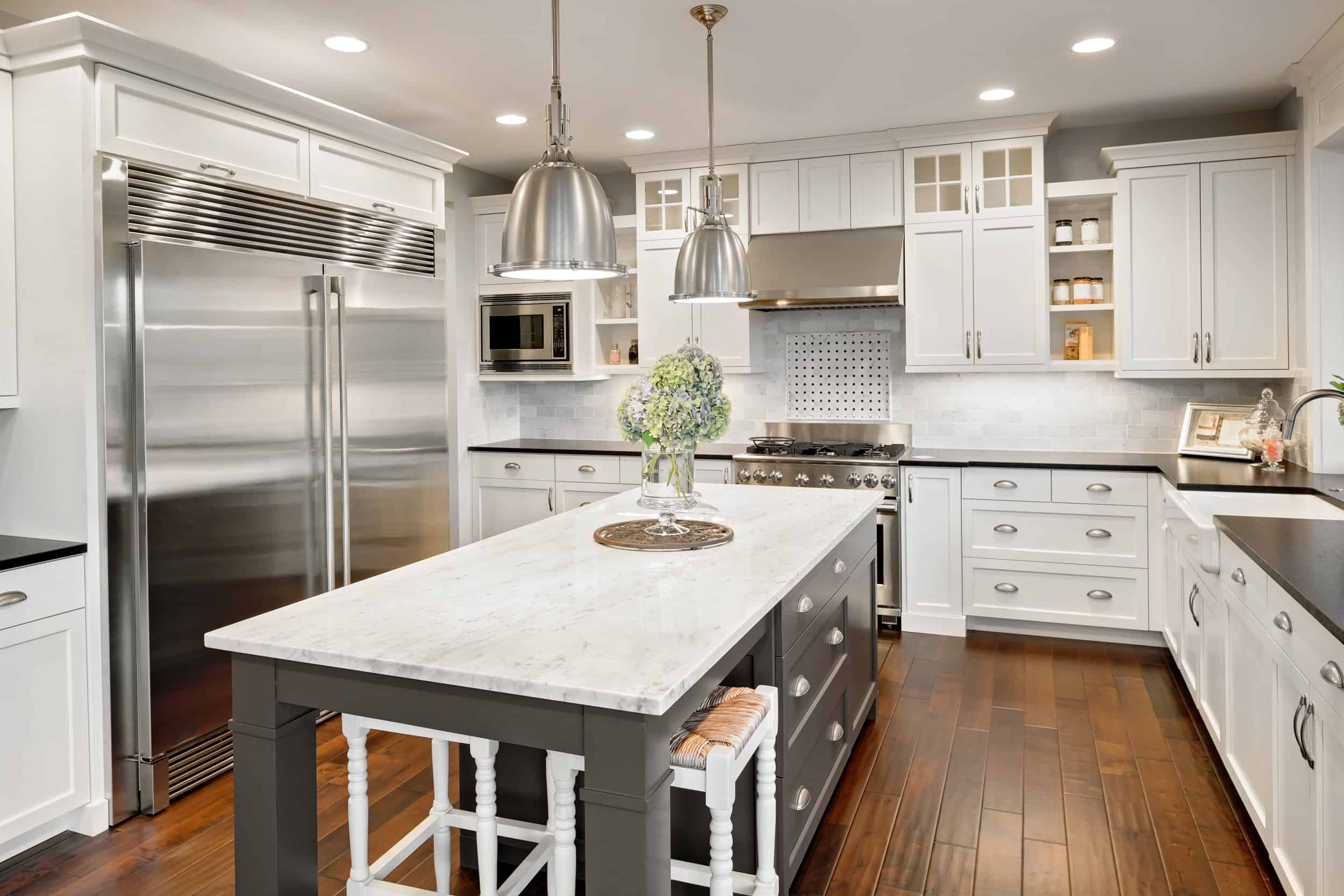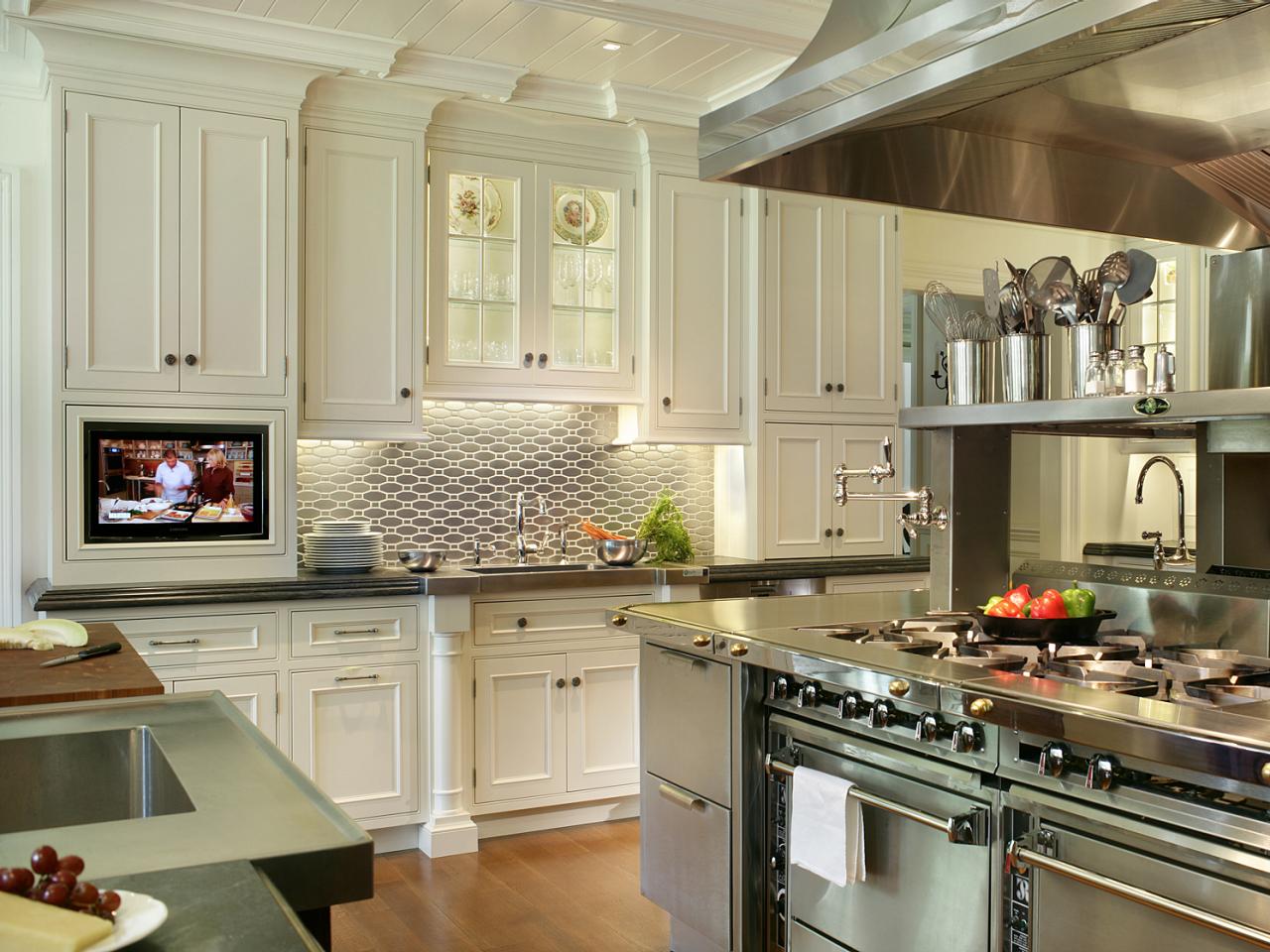Budget-conscious homeowners are better off sticking with standard kitchen cabinet dimensions when designing a new kitchen. There is no comparison between these and custom options. Toe kick height is an important question, so what is a standard height?
In spite of the fact that there are small variations in sizes available for some manufacturers, this article covers the vast majority of standard kitchen cabinets on the market.
The measurements provided here are not the only options since kitchen manufacturers generally have bespoke options, but they can serve as a general guideline for what is readily available.
Height For Kitchen Cabinets
/modern-grey-and-white-wooden-kitchen-interior-1152705690-b1972430558c458e8cc924e765c54ce4.jpg)
This post explains the standard size available for kitchen cabinets, so you can select the best one for you. The reason for this is to help you with budget-conscious kitchen designs, making the most of the space you have while saving money.
Defining toe kick
Toe kicks are the areas at the bottom of the upper and lower cabinets. The toe space is also called the foot space. Located at the bottom of the base cabinet, the toe kick raises from the floor. In bathrooms and kitchen cabinets, foot kicks are installed to enable homeowners to work comfortably on counter-tops.
In most industries, kitchen cabinet height and depth are kept standard. Only the width has been altered. Although it is possible to change some dimensions, professional or manufacturer-specified measurements must be adhered to.

It can be challenging to measure kitchen cabinets and countertops. A cabinet visualizer can help you start the design process by giving you a clear understanding of your interior dimensions. With kitchen countertop dimensions and standard cabinet depth, it’s always a good idea to know your home’s interior dimensions.
You may have found a cabinet that meets all your needs while surfing the web. It would make sense to obtain accurate measurements before ordering so the product would fit perfectly.
Toe Kick Dimensions Standard
If your toe kick depth is greater than 3 inches, you can use it without sacrificing effectiveness. If your toe kick depth is less than 3 inches, you should avoid it, as that interferes with ergonomic effectiveness. An ideal toe kick height is 3 1/2 inches, and heights up to 4 inches are common among athletes.
Three inches is the ideal depth for a toe kick. The counter recess provides a comfortable place to stand while maintaining balance when working at it. The depth standard will be met by most stock cabinets made from factory materials.

Generally, toe kicks with a depth greater than 3 inches do not hurt their effectiveness. However, toe kicks with a depth of fewer than 3 inches should usually be avoided because they interfere with ergonomic effectiveness.
Generally, toe kicks are optimally heightened at 4 inches but are often even higher than that. The extra height will not affect the functionality of your toe kick, but it may lose very slight space in your base cabinet for a few inches after 4 inches.
What Does A Toe Kick Look Like?
There is a notch-shaped recess at the bottom front of a base cabinet known as a toe kick. A recess near the countertop allows the user to place their feet so close to the counter. This can be solved with a very simple design alteration: as you approach the counter, you will see a notch at the bottom of the cabinet.
What is The Proper Distance Between A Toe kick And The Ground?
/cdn.vox-cdn.com/uploads/chorus_image/image/66530483/32_cabinets_styles.0.jpg)
Dimensional Rules for Toe Kicks Toe kicks with depths larger than 3 inches do not impede the effectiveness of the toe kick, but depths smaller than 3 inches should be avoided since they impede the ergonomic benefit. Toe kicks should have an optimal height of 3 1/2 inches, but they can reach heights of 4 inches.
What is The Standard Height of A Toe kick?
3.5 inches is the average height of toe kicks, and 3 inches is the typical depth of toe kicks, as well as the ideal.
How Do You Define Recessed Toe kicks?
In product design, a toe kick is an area between a cabinet base and the floor. The toe space is also called the foot space.
Located at the bottom of the base cabinet, the toe kick raises from the floor. Toe kicks are built into kitchen cabinets and bathroom vanities so homeowners can sit comfortably at the counter while working.
What Are Standard kitchen Dimensions?
Dimensions of wall cabinets:
- Height: 12, 15, 18, 24, 30, 36, 42 inches
- Standard depths are 12, 15, 18, 24 inches
- Standard widths range from 9 to 48 inches, in 3-inch increments

What is The Standard Depth of kitchen Countertops?
The standard depth of a kitchen countertop is 25 inches, so a linear foot is 12 inches wide and 25 inches deep. In addition, if you have your heart set on granite but your wallet is set on laminate, there’s good news.
It’s best to avoid taking measurements of your toe kick that are less than 3 inches. Working above the cabinet counter can be uncomfortable if your toes bump against the base cabinet.

This depth allows anybody who works around the cabinet for a long period of time or comes in contact with it may easily maintain balance and lean comfortably.
A measurement of more than three inches deep has never been considered particularly dangerous by any player. Thus, deep measurements do not adversely affect the effectiveness of the toe kick, not even more than the standard measurement.
Ideal Toe Kick Dimensions And Height For Cabinets
There is a notched profile at the bottom of every cabinet in your kitchen or bathroom, located beneath its front door. An ergonomic feature designed to make working at the cabinet’s countertop more secure and comfortable is the notched profile, called a toe kick.

The small amount might seem insignificant, but long experience shows that it makes standing for long periods of time much more comfortable, allowing the user to stand for a long time without uncomfortable leaning or struggles to maintain balance.
Toe kicks follow a fairly common dimension standard for home and furniture design, as do many other standard features. Toe kick measurements are so universal that factory-made stock cabinets always have these dimensions and any experienced carpenter or woodworker who makes a base cabinet including the standard toe kick measurements.
There is no legal requirement or building code requiring standards such as these. It is wiser to follow these measurements instead unless specifically directed otherwise; rather, builders have long established that such measurements provide greater comfort and safety.
Kitchen Wall Cabinets
There are a lot of options when it comes to kitchen wall cabinet dimensions. The top cabinets are usually determined by the bottom cabinets, ovens, windows, and appliances.
There must also be a 15-inch space between the counter and the bottom of the cabinet in order to determine the cabinet height, even though 18 inches is the standard.
Choosing the right wall cabinet can make a big difference in how your kitchen appears. Increasingly, cabinets are being replaced with open shelves in the kitchen to make it look airier. However, this means regularly dusting and styling open shelving.

You may also forfeit the ability to store things on these shelves. This might not be an issue in a bigger kitchen, but we don’t all have so much space to give up, so this might not be a problem for us! In addition to providing storage, glass doors can also add a sense of openness.
In addition to cabinets that reach the ceiling, we can finish them all off with crown molding. It gives the room a polished look if you have the budget for it.
Alternately, it is possible to leave some space between the top of the cabinet and the ceiling. An extended cabinetry system might appear overbearing in a home with high ceilings.
It all depends on the look you want. You will often find cabinets at different heights around the sink or stove, so make sure the crown molding will fit when you vary the cabinet height.
Wall cabinets in the kitchen are usually 12 inches deep, but there are a lot of options to accommodate the appliances you want to use. It is possible to build deeper cabinets beneath upper cabinets, for example.
Kitchen Base Cabinets
There is a 24-inch depth to the base cabinet. You lose approximately an inch of space on the inside if you measure the cabinet by its outside dimensions.
A deeper version of the cabinet can be placed adjacent to the refrigerator.
A refrigerator that is not counter depth (23 inches deep) sticks out about six inches, which is really ugly.
When you plan carefully, you can get cabinets up to 36 inches deep that will let you use a regular fridge and keep the extra 3-5 cubic feet of refrigerator storage. In this case, a pantry would be more appropriate.

In contrast, once you reach past the 24-inch mark, plugging in appliances and reaching the back is difficult. A significant amount of deeply recessed cabinetry would be undesirable.
In order to qualify for base cabinets, their height must be at least 34 inches. A variety of appliances must fit your base cabinet height since there are so many appliances you will want to use. Under your countertop, you should locate your dishwasher, and the top of your oven should be level with your countertop.
It is really possible to adjust the sizes of the toe kicks in order to make the cabinet height higher. Those who are tall may find a taller cabinet more comfortable. Cabinetmakers will have no problem with this request.
It would be necessary to place boards under the base of prefab cabinets in order to raise them. The Ikea cabinets have a feature called adjustable feet, which you can raise up to the tallest setting.
Keeping your kitchen items safely stored is crucial when choosing your base cabinets. If drawers are a better option than bottom shelves, choose them! When searching for items on bottom shelves, people don’t like to bend over to reach them.
Tall cabinets
If you don’t mind sacrificing some countertop space, tall cabinets are great space savers. In essence, these cabinets extend from their base to their ceiling.
With their shorter lengths, the higher ones let you open up around 12 inches at the top if your kitchen’s ceiling height is average.

Cabinets taller than 96 inches will not have this space. Depending on the width and depth, the unit may be 12 to 36 inches wide. Choosing the right one depends on how much space you have.
Most people use tall cabinets for storing food in their pantry or as utility cabinets. If you are storing food, you may want to choose a shallow cabinet (12 inches) to ensure easy visibility, although you can choose a deeper cabinet so that you can use separate pullouts for each item.
Drawer in the Toe kick
Having some room to place your toes between your work and the desk is definitely beneficial when you have to stand for hours in front of a work surface.
No wonder, having a lot instead of some area down below in terms of height is tempting. A higher cabinet toe kick measurement, however, would likely mean less stock room for you.
However, you need not worry; toe kick drawers can solve your problem. These are drawers that are located right under the cabinet, under the toe kick, which are of great use.
The recessed area below the toe-kick can be used to house your utilities instead of the traditional toe-kick. The toe kick dimensions of the cabinets could be increased without affecting the amount of stock you have. If not in use, the drawers can be hidden from view.
Frequently Asked Questions




